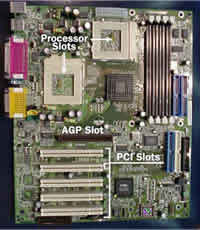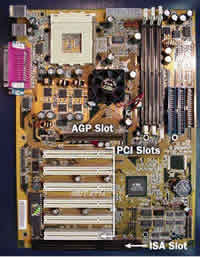The motherboard has
been an integral part of most personal computers for more than 20 years.
Think of a motherboard as a scale model of a futuristic city with many
modular plug-in buildings, each using power from a common electrical
system. Multiple-lane highways of various widths transport data between
the buildings. The motherboard is the data and power infrastructure
for the entire computer.
Motherboards (also called mainboards)
are actually a carryover from architecture used for years in mainframe
computers. Various circuit cards performing various functions all plug
into many similar sockets on a common circuit board. Each circuit card
performs a unique function in the computer and gets its power from the
socket as well.
Due to improvements in circuitry
and packaging, motherboards have essentially stayed the same size or
shrunk (in square inches), while their functionality has skyrocketed
in the past 20 years. In this edition of , you
will learn more about how the motherboard works, and about a motherboardís
many sockets and connectors.
A Brief History
The original IBM PC contained the original
PC motherboard. In this design, which premiered in 1982, the motherboard
itself was a large printed circuit card that contained the 8088 microprocessor,
the BIOS, sockets for the CPUís RAM and a collection of slots
that auxiliary cards could plug into. If you wanted to add a floppy
disk drive or a parallel port or a joy stick, you bought a separate
card and plugged it into one of the slots. This approach was originally
pioneered in the mass market by the Apple II machine. By making it easy
to add cards, Apple and IBM accomplished two things:
Motherboard Sizes
Different motherboards of different vintages
typically have different form factors. Form factor essentially
means the size and shape of the actual motherboard. There are more than
a half-dozen form factors for motherboards, with the most recent ones
having the designation of NLX. Right now, the designation ATX
is the most prevalent. By buying a computer with a true ATX motherboard,
you are assured that you will have the ability to upgrade by being able
to re-use the personal computer case with a more recent replacement
ATX board design.
Motherboards have helped to
keep the "personal" in personal computing since pluggable components
allow the user to personalize the system depending on their applications
and needs. For example:
-
A prolific collector of
digital camera images or video will want to add a SCSI hard disk
drive to an open bay and use an empty socket on the motherboard
for the SCSI controller card.
-
A serious game enthusiast
will want the fastest video card possible with as much memory on
the card as possible.
Common Motherboard Items
A motherboard is a multi-layered printed
circuit board. Copper circuit paths called traces that resemble
a complicated roadmap carry signals and voltages across the motherboard.
Layered fabrication techniques are used so that some layers of a board
can carry data for the input/output, processor and memory buses while
other layers can carry voltage and ground returns without circuit paths
short-circuiting at intersections. The insulated layers are manufactured
into one complete, complex "sandwich."
Chips and sockets are soldered
onto the motherboard. For example, you will typically find:
-
one or more microprocessors
-
a basic input/output system
chip (BIOS)
-
memory slots
-
a chip set that
adds lots of features like I/O ports and controllers
-
peripheral component interconnect
(PCI) adapter card slots
-
industry standard architecture
(ISA) adapter slots
-
accelerated graphics port
(AGP) video card slots
-
universal serial bus (USB)
ports
-
cooling fan(s) on heat
sinks of processor and some video cards
Examples
The MSI 694D Pro AR supports dual Pentium central
processing units (CPUs), has five PCI slots and a communications network
riser (CNR) slot. The board supports 133 MHz bus speeds and ultra-direct
memory access-100 (UDMA). There are four USB ports and onboard audio
in the ATX form factor board.
|

MSI 694D Pro AR Dual Flip Chip Socket 370 Motherboard
|
The Abit KT-7A supports Advanced
Micro Devices (AMD) processors and has the KT-133A chipset. The card
slots on the Abit KT-7A, from bottom to top, shows below that ISA has
one slot, PCI has six slots and AGP has one slot. A special fan cools
the chipset.
|

Abit KT-7A AMD Processor Motherboard
|
A partial view of the TechRam
S3ProM motherboard shows slots, from bottom to top, that ISA has one
slot, PCI has two slots, audio modem riser (AMR) has one slot, and AGP
has one slot.
|

TechRam S3ProM Motherboard
|
The BIOS chip is common to
many motherboards.
|

BIOS Chip
|
Data Bus Width
Modern Pentium class motherboards have
a data bus with 64 bits. That is the width of the data highway that
goes in and out of the processor. The Pentium processors, however, do
use 32-bit registers to handle 32-bit instructions.
Bus speeds and widths have
increased due to faster processors and the needs of multimedia applications.
Typical bus names and widths (in bits) are:
-
Industry Standard Architecture
(ISA) - 8 or 16 bits
-
Extended Industry Standard
Architecture (EISA) - 8 or16 bits
-
Microchannel Architecture
(MCA) - 16 or 32 bits
-
VESA Local Bus (VLB) -
32 bits
-
Peripheral Component Interconnect
(PCI) - 32 or 64 bits
-
Accelerated Graphics Port
(AGP ) - 32 bits
How Have Motherboards Changed?
Speeds, temperatures, density, faster
chipset designs and component count have driven the need for circuit
cooling via miniature electric fans. These fans mount inside the actual
computer case. Heat sinks act like an automobile radiator and provide
additional surface area to help cool a component. Replaceable fan-heat
sink assemblies are often used to help dissipate the considerable amount
of heat on modern processor chips. The fan-heat sink assembly conducts
heat away from the chip by convection, using a layer of thermal grease
between the two mating metal surfaces. Fans often have a third wire
used for monitoring the speed of the fan.
Modern motherboard designs
include provisions for monitoring:
-
fan speed in RPM for the
personal computer case, processor and power supply fans
-
temperatures of motherboard
and processor
-
personal computer case
intrusion
PCI slots are replacing the
older ISA slots, and both types of slots are being replaced by USB ports.
USB ports can also be used to replace the usual keyboard, mouse and
printer ports. Sound card function is also typically incorporated into
modern motherboards. Multifunction chips are on the horizon that will
do even more multiple tasks.
The additional function on
the motherboard saves the motherboard manufacturer costs because:
-
there are less warranty
claims due to problems associated with all the many electrical contacts
(fasteners) in the usual card slot
-
there are lower power supply
wattage requirements
-
there are savings from
elimination of a slotís socket and its space on the motherboard
The consumer can still upgrade
function integrated on the motherboard (such as audio and game controls)
so long as the motherboard manufacturer provides a means of disabling
the function in order to prevent subsequent system resource conflicts.
A motherboard still may have
voltages present on it even if the computer is switched off due to recent
advances in power management and power controls. Always make sure that
the power cord is unplugged!
Chipsets
Chipsets provide the support for the processor chip on
the motherboard. The Intel 440BX is the dominant chipset in the non-Apple
personal computers. The chipset is the heart of the computer since it
controls and determines how fast and which type of processor, memory,
and slots are used. Another chip on the motherboard is called the Super
I/O controller. Its main function is to control the floppy disk drive,
keyboard, mouse, serial and printer ports.
Recent motherboard designs
include additional chips to support USB, sound card, video adapter,
computer host and network adapter. These chips save the cost of an adapter
slot.
Advice on Motherboards
When buying a motherboard, follow these
tips:
-
Deal only with a reputable
manufacturer.
-
Ensure that it has the
same form factor as your current case.
-
Read the booklet that comes
with your motherboard. It should fully cover the motherboardís settings
and specifications.
-
Check the power supply
requirements for AMD processors. Some motherboards have unique requirements.
-
Verify the form factor
of your computer case matches the form factor of any motherboard
you plan to buy.
-
Avoid tweaking voltages
and timings to get more speed out of a computer ("overclocking")."